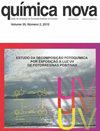RAPID METHOD FOR SIMULTANEOUS DETERMINATION OF CIS-9, TRANS-11 AND TRANS-10, CIS-12 CONJUGATED LINOLEIC ACID ISOMERS IN MILK BY GC-FID
IF 0.7
4区 化学
Q4 CHEMISTRY, MULTIDISCIPLINARY
引用次数: 0
Abstract
Ruminant milk is the lead source of conjugated linoleic acid (CLA) in the human diet, with cis-9, trans-11 CLA being the major among all. Small amounts of trans-10, cis-12 CLA are also found in synthetic supplements. Since both isomers are biologically active with potential health benefits, there is great interest in quantifying them for quality control routines. An alternative method for the analysis of the aforementioned CLAs by fast gas chromatography (GC) is discussed in the present study. The fatty acid methyl ester mixture obtained by alkaline catalysis was injected into a GC equipped with a flame ionization detector (FID) and fitted with an ionic liquid SLB-IL111 chromatographic column (15 m × 0.10 mm × 0.08 µm). Separation was achieved in less than 5 min using a 168 °C isotherm run. Both CLA isomers were quantified by using of single point standard addition statistical approach. Results were contested to those obtained using the recommended 100 m long CP-Sil88 capillary column and none evidence of significant differences was found within 95% confidence interval. Therefore, the proposed method could be valuable to focused regulatory routines of large numbers of samples with greater analytical frequency.gc-fid快速同时测定牛奶中顺式-9、反式-11和反式-10、顺式-12共轭亚油酸异构体
反刍动物奶是人类饮食中共轭亚油酸(CLA)的主要来源,其中顺式-9、反式-11是共轭亚油酸的主要来源。在合成补充剂中也发现了少量的反式-10和顺式-12 CLA。由于这两种异构体都具有生物活性,具有潜在的健康益处,因此对它们进行量化以进行质量控制程序非常有兴趣。本研究讨论了快速气相色谱法(GC)分析上述CLAs的替代方法。将碱催化得到的脂肪酸甲酯混合物注入配备火焰电离检测器(FID)的气相色谱中,并安装离子液体SLB-IL111色谱柱(15 m × 0.10 mm × 0.08µm)。使用168°C等温运行在不到5分钟的时间内实现分离。两种CLA异构体均采用单点标准加法统计方法进行定量分析。结果与使用推荐的100 m CP-Sil88毛细管柱获得的结果存在争议,在95%置信区间内没有发现显著差异的证据。因此,所提出的方法可用于分析频率较高的大量样品的集中监管程序。
本文章由计算机程序翻译,如有差异,请以英文原文为准。
求助全文
约1分钟内获得全文
求助全文
来源期刊

Quimica Nova
化学-化学综合
CiteScore
1.60
自引率
12.50%
发文量
72
审稿时长
2-4 weeks
期刊介绍:
Química Nova publishes in portuguese, spanish and english, original research articles, revisions, technical notes and articles about education in chemistry. All the manuscripts submitted to QN are evaluated by, at least, two reviewers (from Brazil and abroad) of recognized expertise in the field of chemistry involved in the manuscript. The Editorial Council can be eventually asked to review manuscripts. Editors are responsible for the final edition of QN.
 求助内容:
求助内容: 应助结果提醒方式:
应助结果提醒方式:


